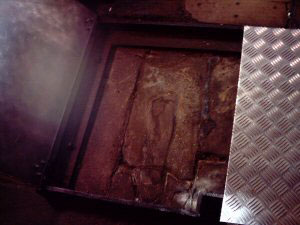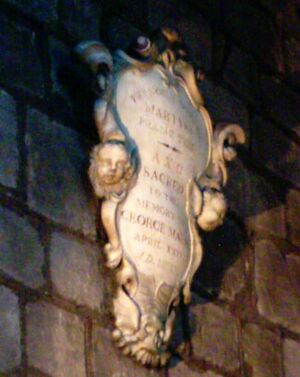George Marsh (martyr) facts for kids

George Marsh (born 1515, died April 24, 1555) was an English Protestant who died for his beliefs. He is known as a martyr. He was executed in Boughton, Chester, during a time called the Marian Persecutions. This was when Queen Mary I punished Protestants and other people who disagreed with her religious views. George Marsh's story is told in a famous book called Foxe's Book of Martyrs.
Contents
Early Life and Beliefs
George Marsh was born and grew up in a place called Deane, near Bolton, in Lancashire. He worked as a farmer. When he was 25, he got married. After his wife passed away, he left his children with his parents. He then went to Cambridge University. There, he met people who believed in the reformed faith, which was the Protestant way of thinking. He likely became a Protestant while studying there.
In 1552, a bishop named Nicholas Ridley made him a deacon. The next year, George Marsh became a curate (a church assistant) in places like Church Langton and London. People said he was tall and very good at speaking. He was a popular preacher.
Preaching and Arrest
George Marsh worked for King Edward VI for a while. But when Queen Mary I came to power, things changed. She was a Catholic and wanted England to return to the Catholic Church. After his friend Lawrence Saunders was arrested in 1554, George Marsh went back north. He kept preaching the Protestant faith in areas like Deane and Eccles in Lancashire.

Soon, an order was sent out to arrest Marsh for heresy. This meant he was accused of having religious beliefs that went against the official church. He gave himself up at Smithills Hall in Bolton. Local stories say that when he was questioned there, he stamped his foot so hard to show his strong faith that it left a mark in the stone floor.
Imprisonment and Trial
Marsh was questioned at Lathom House by the Earl of Derby. People hoped he would change his mind and agree with the Queen's religion. But George Marsh refused to give up his Protestant beliefs. Because he would not change his mind, he was taken to Lancaster Gaol (a prison). He stayed there for almost a year. During this time, he read from the Bible and prayed. Townspeople would gather outside his window to listen.
Later, he was moved to a prison in Northgate, Chester. He had his trial at Chester Cathedral. Bishop George Cotes oversaw the trial. Marsh still refused to become a Catholic. Even when he was tied to the stake, just before his execution, he was given one last chance to change his mind. He refused. His time in prison is written about in Foxe's Actes and Monuments.
Execution
George Marsh was executed in April 1555. He was burned to death at the stake in Boughton, about a mile from Chester city centre. This was a common way for people accused of heresy to be punished at that time. After he died, his friends gathered his ashes. They buried them in the nearby Saint Giles' Cemetery.
There is no special marker for him in the cemetery. However, a note on an inscription mentions him:
St Giles Cemetery. Here stood the leper hospital and chapel of St Giles. Founded early in the 12th century and endowed by successive Norman earls of Chester they remained in constant use until 1643. When defensive measures during the siege of Chester necessitated the demolition of buildings outside the city walls. The cemetery remained to mark the site and in time the little village of Spital Boughton clustered around it. In 1644 the royalist defenders suffered great loss of life in a gallant sortie in Boughton and many of the fallen were buried here. It was also used for victims of the plagues which ravaged the city in the 16th and 17th centuries. Being extra parochial the site was granted to the corporation by Charles II in 1685. As a burial ground and through for a period in the charge of St Johns parish. It remains in their hands. When Protestant martyr George Marsh was burned at the stake on gallows hill close by his ashes were collected by his friends and buried here. The last burial took place in 1854.
Memorials

There are two memorials for George Marsh at St Mary's Church in Deane. One is the base of an old cross in the churchyard. People say it was once a Saxon cross where early Christian preachers taught. Inscriptions on its base remember his death and the memorial set up in 1893. A stained-glass window was also made for him in 1897. It shows Faith, Charity, and Hope.
In Chester, George Marsh has two memorials. One is in St John the Baptist's Church. The other is a tall stone pillar called an obelisk. It was put up in 1888 beside a road in Boughton. It has this message:
George Marsh born Dean Co. Lancaster. To the memory of George Marsh martyr who was burned to death near this spot for the truth sake April 24th 1555.
Legacy and Influence
At Smithills Hall, you can find some of George Marsh's personal letters and journals. There is also a 17th-century copy of John Foxe's Book of Martyrs, which tells the story of his trial. Even today, Protestants in Chester gather around April 24th to remember George Marsh's life and death.


